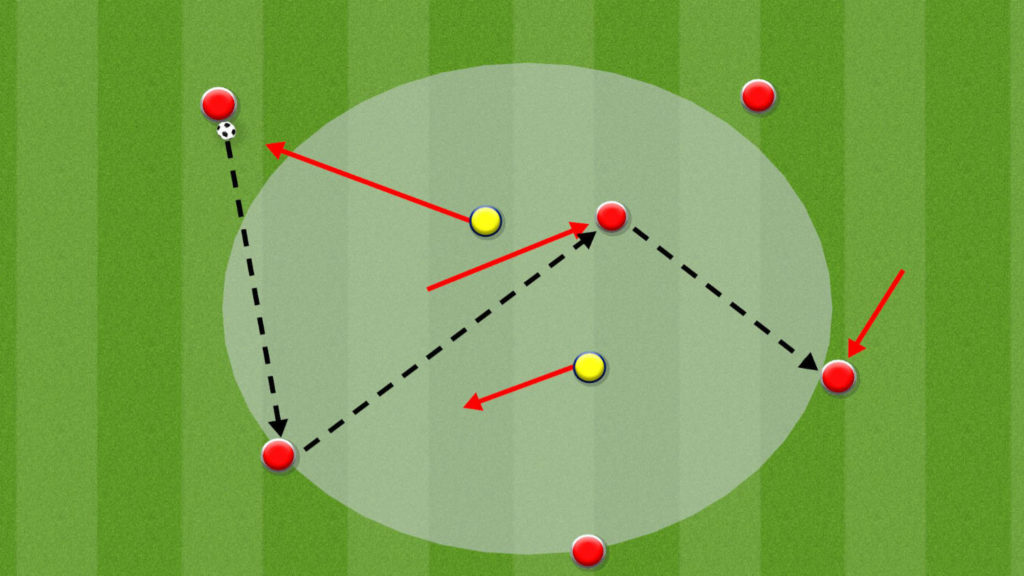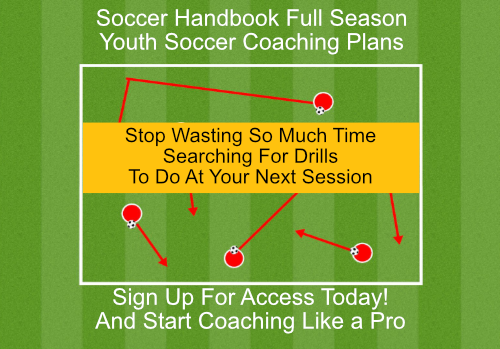A rondo is a soccer possession game. It is also known as keep-away or similar to the children’s game ‘monkey in the middle.’
There are many variants of the idea, but it always consists of a group keeping the ball away from one or more than one defender. It is mostly used as a warm-up in practice or before a game, but the concept can be expanded into a full training exercise.
Why is it Called a Rondo?
The word “rondo” originally comes from the Italian version of the French word rondeau, which means “a little round.” This version of the word was primarily used in music.
The term “rondo” used in soccer, was coined by Spanish coach Laureano Ruiz in 1957. Since Ruiz is of Spanish descent, this version comes from the Spanish language and references the round shape of the drill.
What Makes the Rondo so Effective in Coaching?
The Rondo is extremely versatile, and while it is very simple and can be played in a small space, it includes many facets and skills of developing players of all ages and levels in the full game, including;
- Passing
- Ball control
- 1 & 2-touch
- Team shape – Width and Support
- Teamwork
- Defending – pressure and cover
- Transition
- Communication
- Body-shape
- Movement
- Awareness/Scanning
There is also a social, fun, and competitive aspect that makes it such a great exercise or drill for all ages, from grassroots to the professional level.
“Everything that goes on in a match, except shooting, you can do in a rondo.”
Johan Cruyff
Coach Pep Guardiola and his teams have popularized and successfully evolved the rondo in recent years to help players’ technical and tactical abilities. This popularity has spread across professional teams and nations all the way down to the youngest developmental level.
How Do You Play a Rondo?
The players in possession keep the ball until the possession is lost by;
- Tackle
- Interception
- Loss of possession outside the circle
Usually, the defender that wins the ball switches with the last attacking player who either lost it or produced the wayward pass or control.
The playing area can be an imaginary circle that doesn’t necessarily have to be confined by cones, but the coach or players can change the size fluidly as the game goes on.
Generally, a 4v1 rondo might be no larger than 7x7yds up to 10x10yds, but again this can be changed by the players or coach to suit their developmental level.
A coach can set a pass or time limit and take turns to defend. This way, players aren’t either attacking or defending for too long. But the nature of the game means the play and transition is usually quick.
Rondo Soccer Drills
Some of the variations include progression or incorporation into a different exercise. This might help start a drill or show how it can be used in positional play or how it can translate to the full game. Here are a few popular variations:
3v1 and 4v1
3v1 and 4v1 are the simplest form of rondos. Keep away, passing and moving and competition at its purest.

5v2 Rondo
This is a popular iteration as it has an extra defender to simulate a pressure and cover situation, meaning the defenders have to communicate and work together, adding more game-like development. You can also play to split the defense, which adds a layer of difficulty. The players in possession try to move the ball to split the defenders and play through the defensive line. This can help players understand and develop ‘breaking the line’ (advancing the ball through a line of opposing players) with a pass.

Central Player Rondo
Involve a central player to give the aspect of linking play and creating triangles, which helps support the attack. The central player can develop an understanding of spatial awareness, similar to moving between the lines or in the half-spaces. They can then play on the shoulder of the defender or employ sharp double-movement to find space.

2 Teams vs. 1 Team Rondo
With three equal teams in a larger space. Red, Yellow, and Blue try and keep or possess the ball. Two teams, e.g., red & blue, work to keep the ball from yellow. If yellow wins the ball from blue or the ball goes out of play, those two teams transition. Now red and yellow are keeping it away from blue.
This takes the rondo onto a bigger field, and there is free movement.

Switch the Field & Across the River
Variations on the rondo can help players understand how possession and moving the ball can help create space in other areas of the field. For example, this drill shows how close possession can draw defenders across to one side of the field so the ball can be switched to open space. This also helps defenders develop and understand Pressure, Cover & Balance – these are key concepts within defending.
This can again be expanded into a conditioned game where once the ball is switched, the attacking team can go to a goal, just as they would in a real game. The only real negative aspect of the traditional rondo that makes it less game-like is the fact there is no direction to the play, which is something the rondo doesn’t traditionally have. In some rondo games, like ‘Switch the field,’ you can add a goal(s) to play to in order to add directional play.

Another example that adds direction is “Across the River.”

Progressions of the Rondo
You can change the difficulty of the rondo very easily to ensure the players are challenged or are having more success:
- Adding or taking away attackers and defenders
- Reducing or increasing the playing area
- Changing the number of touches – 1 or 2 touch is a great way to get players moving the ball quickly and increasing their technical development and speed of thought.
- Add a points system or a number of passes to be reached as a goal.
- ‘First pass is free’ is often something players use, particularly when learning. This means, at the start of a new round, the first pass cannot be intercepted by a defender to give the possession team more of a chance to get the possession going – the coach can decide if you want this rule. But, as it’s not true to the game (you don’t get free passes on the field!) then, it might be something a coach might forego.
The Art of the Rondo – A Brief History
The term and exercise of ‘Rondo’ were first coined and credited to Spanish coach Laureano Ruiz in 1957. After joining Barcelona as a coach in 1972, he used it during the great Dutchman Johan Cruyff’s tenure as a player through the 1970s. Who, in turn, used it in his own coaching practices as the coach of Barcelona in the 90s. It was at this time a young Pep Guardiola started his playing career at Barcelona. His coaching would become heavily influenced by Cruyff during this time.
Johan Cruyff saw the importance of the rondo in training to complement the Dutch-based ‘Total Football.’ The system Barcelona had adopted under his mentorship that he had taken from Dutch coach Rinus Michels. Cruyff said of the rondo, “Everything that goes on in a match, except shooting, you can do in a rondo.”
The Rondo has since gained mass popularity in soccer as Guardiola’s own Barcelona team of 2008-2012 used it prominently. The technical and positional aspects have played a large part in helping Guaridola’s team develop his possession-based Positional Play and the ‘tiki-taka’ that the all-conquering Barcelona and Spanish National Team employed most effectively during this time.
It was not just Guardiola’s teams that have used the Rondo. Its popularity has complemented the possession-based style many top professional and international teams have made fashionable and gained success with throughout the last decade. The rondo has become a staple of coaches in helping development from the grassroots to the top level of the game.






